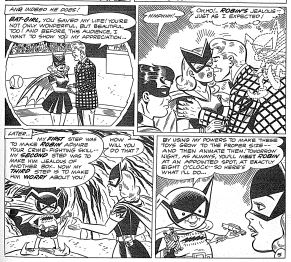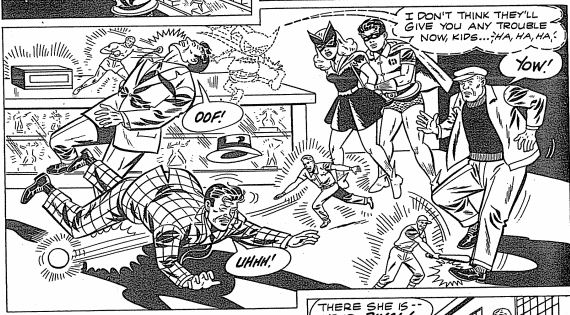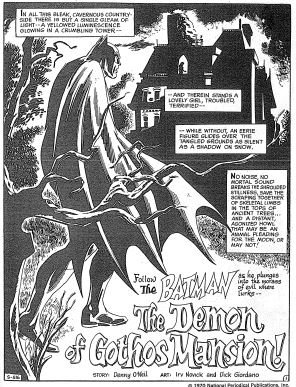Wrath is All They Have: The Fall of the Bat-Man in 7 decades, 14 Pictures
Wednesday , 1, April 2015 Uncategorized 3 Comments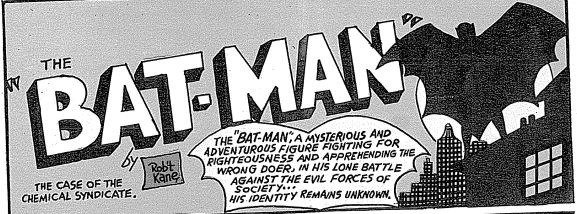
The Batman appears for the first time in Detective Comics #27 fully formed, and, importantly, without origin story. He is “A Mysterious and Adventurous Figure Fighting for Righteousness and Apprehending the Wrongdoer. In His Lone Battle Against the Evil Forces of Society…His Identity Remains Unknown.”
In the same issue (which appeared in 1939), the Batman strikes an iconic and oft-repeated pose: that of a terrifying night creature shocking petty thugs in some secluded urban recess.
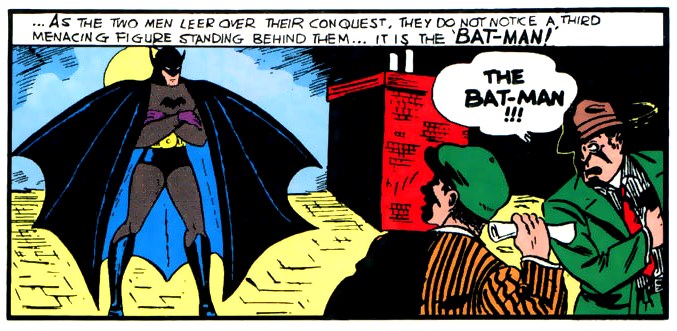
Finally, it is in this first appearance that The Batman establishes that the use of violence – even if it kills a crook – can be both an acceptable and just remedy.
This:

Leads directly to this:

Incidentally, until about 1940, the Bat-Man was also a gunslinger. Then, the editors changed this for what appears to be purely artistic reasons: giving the hero an aversion to using guns against criminals due to the childhood trauma of losing both parents to murder by gunman. This also relates to his taking on a ward in the young Dick Grayson – Robin – whose parents were shot to death by the mafia.
He dropped a lot more than guns following the implementation of the Comics Code Authority in 1955. The crime-fighting and mystery solving that had been such a staple of Batman stories during the 1940s and early 1950s gave way to science fiction stories featuring teenage girls, love triangles, and meddling imps from the 5th dimension:
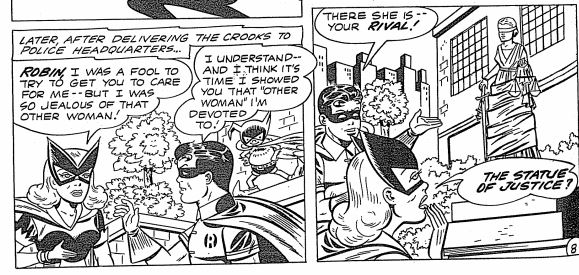
Social Justice prevails. I don’t think the mean ol’ Batman even appears in this issue. Thank goodness for small favors.
Sometime in the late 60s, the science fiction teen romance stories gave way to a resurgence of Batman making more actual appearances in the titles he made famous (Detective Comics and Batman)…as a counselor to emotional women.
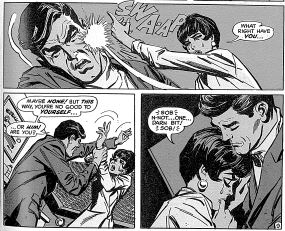
Yes, that is a costume-free Bruce Wayne. And yes, panels like these go on for pages. And pages. Circa 1970. Rex Morgan M.D. – Now with more slapping!
Batman misfired a lot under the Comics Code Authority as he tried to find his way through stories because his original identity as detective and crime-fighter had been so muted by censorship. Ironically, because there were ever-changing interpretations of the Code, Batman’s oddly-fitting soft sci-fi twists from the late 50s and 60s (which were themselves cheats to pull Batman out of the forbidden “crime” and “violence” stories) laid the groundwork for his stories of the 1970s to skirt the Code restrictions on supernatural horror stories:
So, as long as Batman can get out of a noose by swinging himself back and forth in it (don’t worry, Bat-fans, he does!) hangings that were forbidden to Tales of the Crypt flew under the code without comment:

The 1970s provided a lot of interesting work-arounds to the code, but with the rise of the graphic novel in the 1980s, Batman was able to re-establish his credibility as an iconic single-minded crime-fighter. Interestingly, Frank Miller re-cast Batman as an old man, 30 years ahead into an alternate future, emerging from a faked death in a mad quest to take on a world that has itself gone mad:
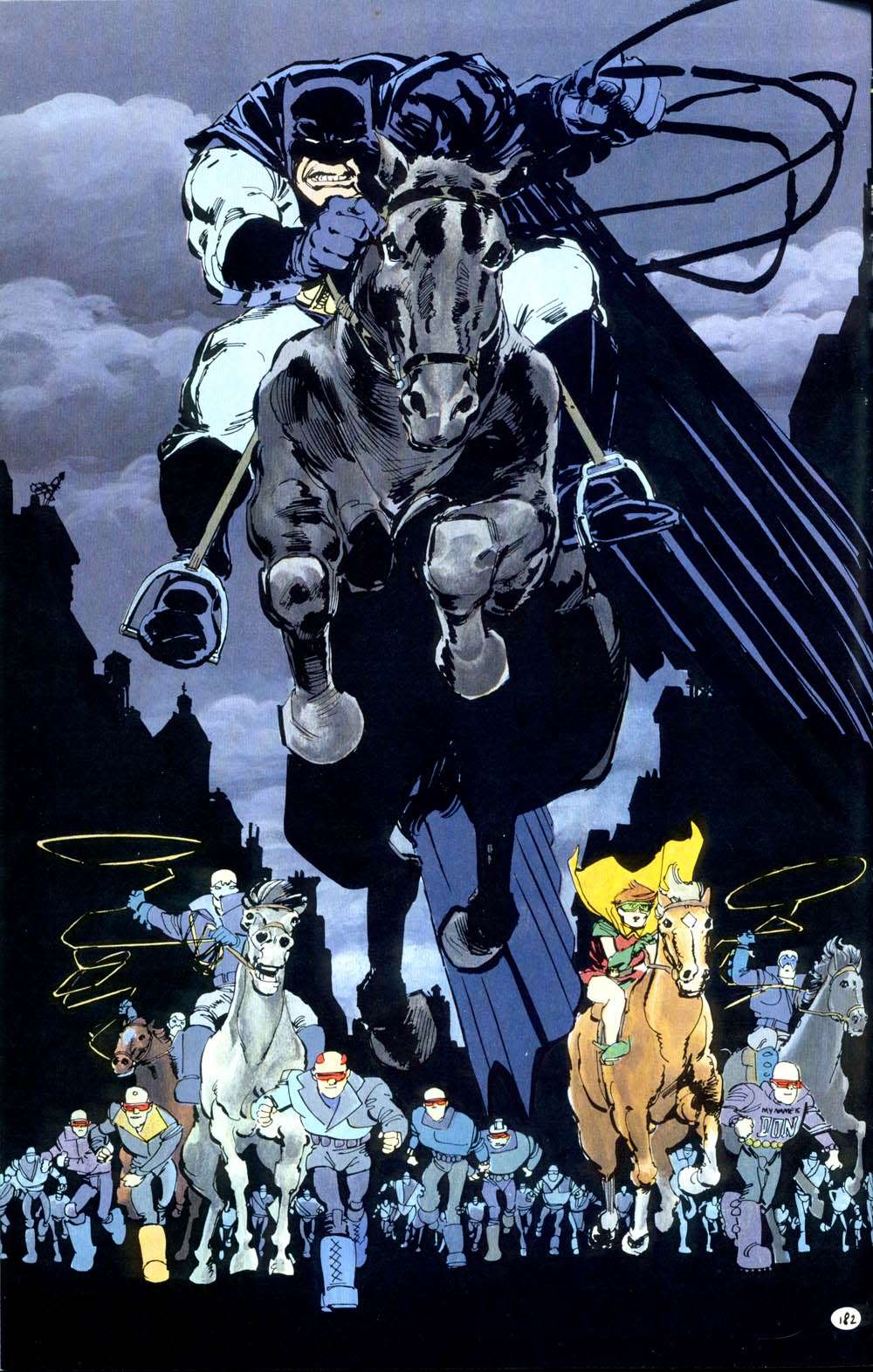
The Dark Knight Returns…as one of the Four Horsemen of the Apocalypse.
This era – not coincidentally – is also marked by a very important upgrade to one of Batman’s chief enemies: The Joker. Although he was originally supposed to be killed by the Batman in his very first appearance in Detective Comics, the Joker eventually became a madcap foil to Batman’s straight man. With The Dark Knight Returns and more importantly, The Killing Joke, the insane but insightful psychopath that inspired Heath Ledger’s performance develops to the point that today, there are many (I do not count myself among their number) dualists who truly believe that the goodness of Batman would cease to exist without the diabolical Joker:

It isn’t just fans’ interpretations. Clearly most writers buy into it entirely. In fact, it didn’t even start with The Killing Joke. The Joker as Batman’s Horrific Funhouse Mirror actually started with the villain’s popular revival in the comics in 1975. He even inspired a spin-off comic that didn’t have much chance of success under the Code. (You couldn’t have a criminal who ever succeeded at his goals, which makes for a rather predictable protagonist.) The philosophy is worthy of Two-Face: With the fairly unbroken string of Batman movies since the late 1980s, including the latest popular overall trilogy, it is arguable that interest in the iconic, crime-fighting detective version of Batman has never been so high.
With the fairly unbroken string of Batman movies since the late 1980s, including the latest popular overall trilogy, it is arguable that interest in the iconic, crime-fighting detective version of Batman has never been so high.
Yet, in 2011, Detective Comics – the longest running title in the history of comic books – removed Batman once again from their pages, replacing him with a host of pretenders to the cowl, and with his apparent death, shut down the record-breaking line. Detective Comics, throughout all the turbulence of its feature character over the years, simply ran out of ideas. The closing off of Detective Comics (now known as Detective Comics, vol. 1) was simply another version of the laughable publicity technique of “killing” a feature character (or superficially turning him into a woman, minority, bowl of petunias, or whatever).
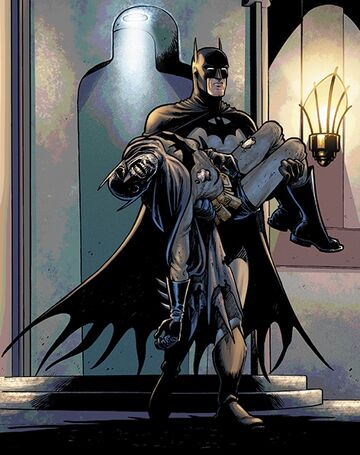
This is not parody: near the end of Detective Comics 70+ year run, the comic featured a living fake Batman carrying a rotted dead fake Batman (an insane clone of Bruce Wayne) in an attempt to resurrect a monster in a supernatural occult vat. The real Batman never actually appeared in the final issues of the title he made famous.
Of course they brought back Detective Comics three months later (“Volume 2”) in a wholly unnecessary “reboot” designed to bring the DC “Universe” back into alignment. (Wholly unnecessary especially when it comes to Batman. His backstory and history has hardly changed a lick in the reboot. Consider that the original volume introduced Bat-Mite, supernatural horror and soap opera without ever rebooting a thing.)
Then again, perhaps the early 21st-century version of Batman who abused and cursed at his now-pouty grieving ward left the publisher with no other option but a reboot.*
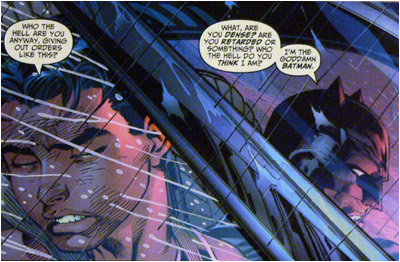
So.
There’s that.
—
*To be fair, that last panel is from the fairly universally derided All-Star Batman and Robin, the Boy Wonder not Detective Comics or Batman proper, but I think it is indicative of how lost that even Batman’s best writers (Frank Miller, mastermind of the now classics The Dark Knight Returns and Batman: Year One penned the above disaster) had gotten towards the end. No one but his fans wanted him played straight anymore.
No one but his fans wanted him played straight anymore.
And thus we find ourselves living in a world where – despite the existence of the absolutely amazing show Arrow – the only Batman show on TV doesn’t even feature an actual, you know, Batman. thus completely removing my desire to see it.
-
Here’s the cold, hard truth Bats. We don’t hate you ’cause we’re crazy. We’re crazy ’cause we hate you
Gardner Fox caught grief for having Batman gun down criminals in those early years.
